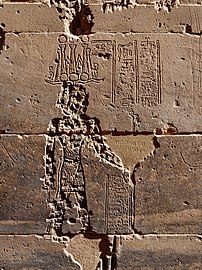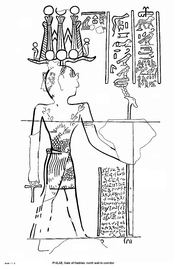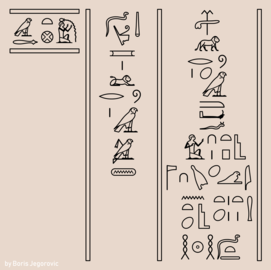Graffito of Esmet-Akhom
The Graffito of Esmet-Akhom (or Philae 436) is the last known inscription written in Egyptian hieroglyphs, dated to 394 CE. It is inscribed in the temple Isis at Philae in southern Egypt.[1]
The inscription accompanies and refers to an image of the Nubian god Mandulis wearing his characteristic crown. In addition to the hieroglyphic text there is also a demotic inscription. The demotic one is dated to "the day of the Birth of Osiris, his (?) dedication-festival, year 110 [ Diocletian epoch ]", corresponding to 24 August 394. At the time, Roman Egypt had been largely Christianised, and Egypt was a separate diocese within the Praetorian prefecture of the East.
The hieroglyphic inscription:
Transliterated:
m-bꜣḥ Mꜣ-w-r sꜣ Ḥr m-ʿ=f Ist-mḍ-iḫm s* r'Ist1-md ḫm-nṯr
Translation in English:
Before Mandulis son of Horus, by the hand of Esmet-Akhom, son of Esmet, the Second Priest of Isis, for all time and eternity. Words spoken by Mandulis, Lord of the Abaton, great god.[2]
The demotic inscription reads:
I, Nesmeterakhem, the Scribe of the House of Writings (?) of Isis, son of Nesmeterpanakhet the Second Priest of Isis, and his mother Eseweret, I performed work on this figure of Mandulis for all time, because he is fair of face towards me. Today, the Birthday of Osiris, his dedication feast, year 110 [of the reign of Diocletian].[2]
 Photograph
Photograph Drawing
Drawing.jpg) Hieroglyphic inscription
Hieroglyphic inscription.jpg) Demotic inscription
Demotic inscription Hieroglyphic inscription (arrangement of hieroglyphs)
Hieroglyphic inscription (arrangement of hieroglyphs)
References
| Wikimedia Commons has media related to Graffito of Esmet-Akhom. |
- "THE ANCIENT EGYPTIAN LANGUAGE: NOT JUST HIEROGLYPHS". American Research Center in Egypt Orange County. Retrieved 2015-04-26.
- Parkinson, Richard (1999). Cracking Codes: The Rosetta Stone and Decipherment. Contributions by Whitfield Diffie, Mary Fischer, and R. S. Simpson. British Museum Press. p. 178. ISBN 978-0-7141-1916-8.
